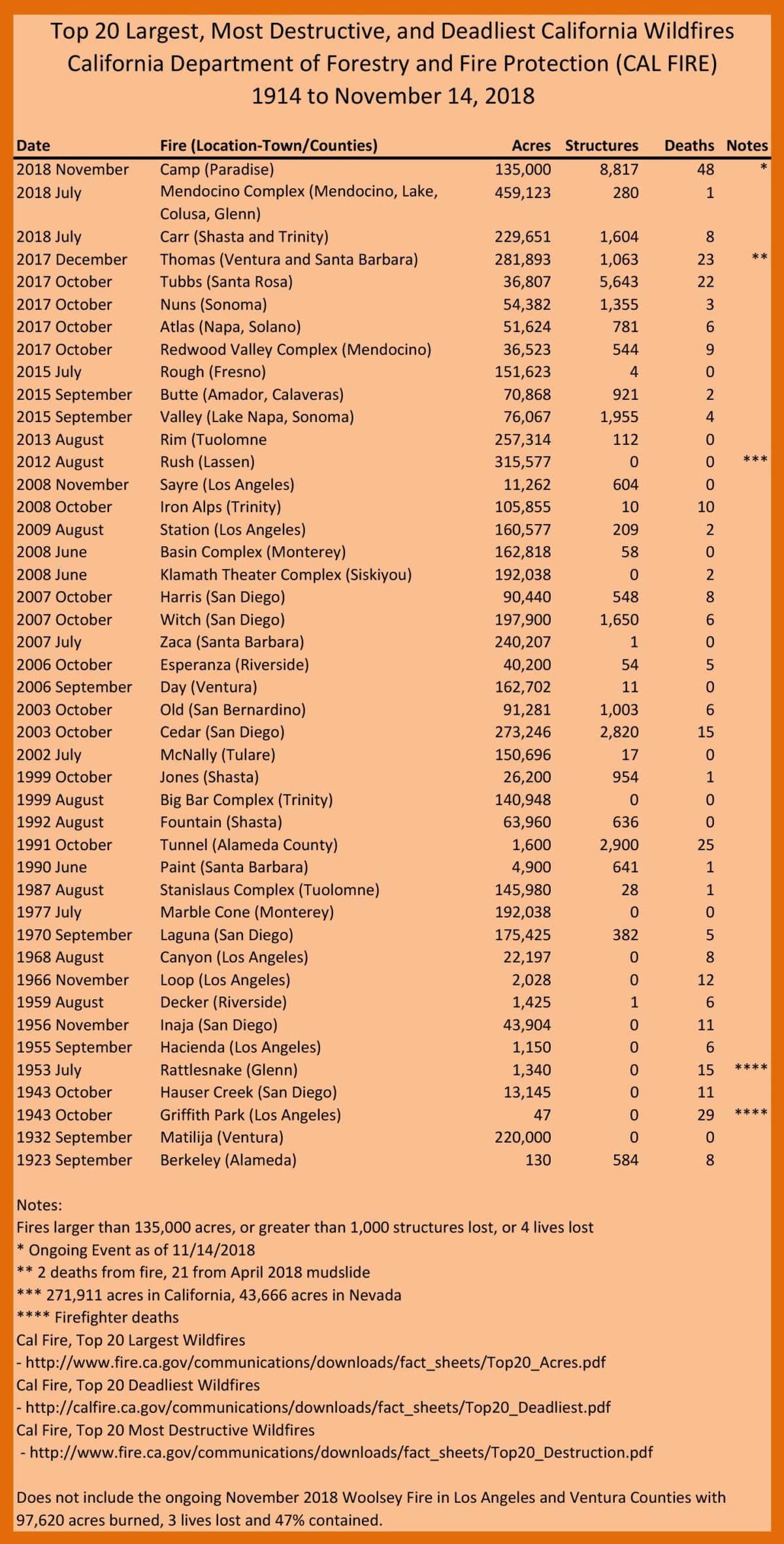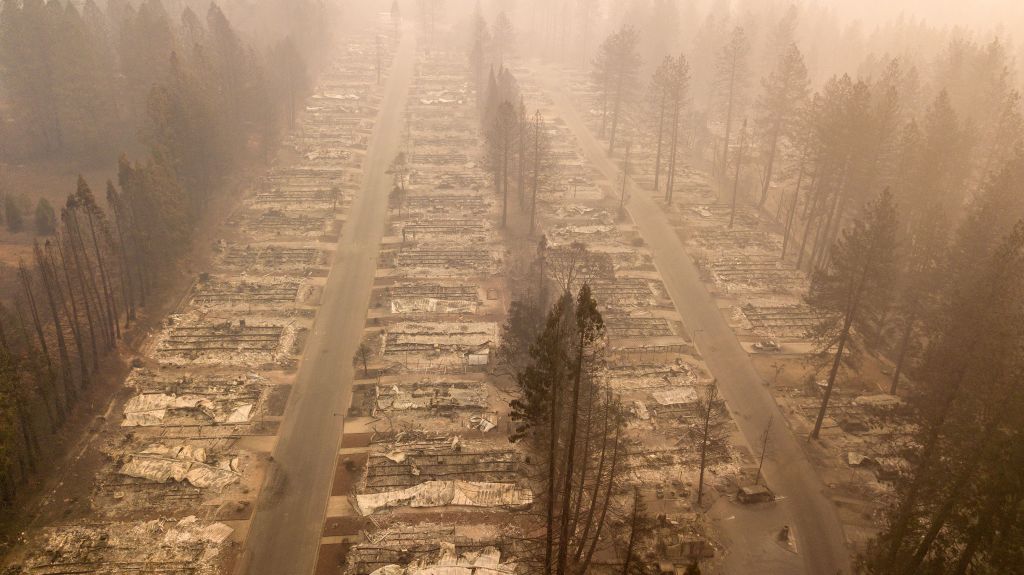Unprecedented droughts, fires and floods are not the “new normal”: Climate change gets nonlinearly worse from here on out. Like an avalanche, the physics of warming determines that a little more warming doesn’t create a little more extremeness, but a lot more. Until we reduce greenhouse gas warming, it gets a lot worse every year. Reducing emissions alone does not reverse warming until after 2300. To reduce warming, we must eliminate all greenhouse gas emissions by 2050, plus remove near 1,000 gigatons of already emitted greenhouse gases from the atmosphere, according to the new 1.5°C report from the Intergovernmental Panel on Climate change.
Meanwhile, a third unprecedented wildfire in California has happened in the last 12 months. At the time of writing, nearly 12,000 structures and 71 lives have been lost in Paradise, California, to the “Camp Fire” that began November 8. Before that, the July 2018 Mendocino Complex Fire burned 459,000 acres and set a record for the state’s largest fire. But the largest fire record before that was set by Thomas Fire, which burned 281,000 acres in December 2017. More than 10,000 structures have been lost in 2018 so far in the state, and more than 9,300 structures were lost in 2017.
The record-setting increases of these unheard-of extreme weather events continues to horrify the public. What will it take to allow us to treat climate change like it is the most important issue our society has ever faced, as top scientists say it is?

Research from the University of California, Irvine tells us that, “The occurrence of extremely large Santa Ana (wind-caused) fires has increased abruptly since 2003.” Since then, burned area in the most extreme fires has increased by 70 percent and structures lost have increased by more than 200 percent, according to Cal Fire statistics (see list above). California’s population however, increased by only 12 percent since 2003. Why has this out-of-balance increase in fire behavior occurred?
A Longer Warm Season
Many of these recent astounding fires in California are human-related, but why has damage and burned area increased so much lately, when firefighting efforts have also proportionally increased?
Human-caused ignition is a compelling argument, but if so, impacts would be only slightly elevated from pre-2003 times because of the 12 percent population increase. Area burned since 2003 has nearly doubled and structures burned has nearly tripled, however. The reason for all of these catastrophes is plain and simple: It’s warmer now.
Warming has immense implications relative to increasing extremes. Basic physics tells us that warming increases evaporation nonlinearly. That is, a little warming creates a lot more drying of fuels. A longer warm season allows drying to compound, amplifying already-increased extreme fire behavior.
Anthony Westerling at the University of California, Merced, published US forest wildfire statistics across the country from 1970 through 2012 in the Philosophical Transactions of the Royal Society B in May 2016. Here’s what he had to say:
- US wildfire season has increased by more than 60 percent since the 1970s, from 138 days to 222 days, because of earlier onset of spring.
- The average burn time has increased nearly 800 percent, from six days to 52 days, because of deeper drying.
- Burned area increased 1,271 percent.
- Human-caused ignition has played a very small role in increasing wildfire trends.
The fingerprint of warming is unmistakable. It’s not increasing population. It’s not increased human-caused ignition sources. Is there anything else that it could be?
President Trump wrongly blames California’s forest management for the increase in extreme fires. Brian K. Rice, president of the California Professional Firefighters, has responded, saying that, “[N]early 60 percent of California forests are under federal management and another one-third under private control. It is the federal government that has chosen to divert resources away from forest management, not California.” Forest management doesn’t even apply to almost all of Southern California. For example, the Woolsey Fire in Thousand Oaks is in scrub typical of southern California, not timberlands.
The prevailing academic thought on forest management is that more dead fuels litter our forests from the Smokey-Bear-era of fire suppression efforts, and this allows more extreme fires. This is good science and certainly played a role in increasing burn behavior before climate warming rose above natural variation 10 or 15 years ago when these unprecedented extremes began to become so numerous.
Today, however, warming has consequences. One of them is that warming creates a drier world; and in a drier world, wildfire is more extreme. Another of these consequences is increased duration of Santa Ana wind events on a warmer planet. The Santa Ana wind that created the Thomas Fire was the longest Santa Ana wind event on record. Santa Ana winds are hot, dry, down-sloping winds from the continental interior that blow offshore in southern and central California, can reach speeds in excess of 70 mph and generally occur in the fall.
If all of the above is not enough to say that climate disruption caused these catastrophes, why do catastrophes happen?
Catastrophes happen when natural event extremeness exceeds a threshold, and extreme fire behavior is just one of these thresholds. Flooding, wind damage, drought mortality, beach erosion, beetle kill, permafrost melt, ice sheet collapse, Gulf Stream shutdown — all of these things are not a problem until a threshold is crossed. We have crossed that threshold with wildfire and all of the above-mentioned impacts because our leaders have delayed action on regulating greenhouse gas emissions.
Without passing through a catastrophic threshold, catastrophes don’t happen. It’s time to stop believing these events are only enhanced or plausibly caused by climate change.
A little bit of warming makes a lot of difference. Nicholas J. Nauslar’s research on Southern California fires tells us that we’ve seen the most acute fire weather in more than two decades, the longest duration Santa Ana wind event in the 70-year record, the most extreme drought on record, the lowest fuel moisture on record and the driest March through December since 1895.
Pushing Back Against the Fairness Bias
The good news is that emissions can be managed; there’s plenty of science that says so. But we have been delayed for 30 years by economic, social, psychological and political forces that have prevented our leaders from acting.
There are players, or organizers of the climate change denial and delay movement, who are directly responsible, as is so well described as the “climate change counter-movement” by professor of sociology and environmental science Robert J. Brulle from Drexel University in 2014, and then detailed by Ruth McKie in 2018 at De Montfort University in 2018. These players have egregiously given license for citizens and leaders to dispute, deny and delay. It’s not just the political conservatives, but they brought it to the table.
The perceived debate, so roundly and unwittingly promoted by the media’s false balance, has influenced our society from stem to stern. This “false balance” is where journalistic norms of presenting both sides of the story equally and fairly allow inaccurate information to be presented with the same weight as accurate information. When all but just a few individual climate scientists agree but a little more than half of Americans believe climate change is human-caused, there’s some powerful deceit going on.
All of us are influenced by false balance, from laypersons to advocates to leaders. Even climate scientists are impacted by the false balance because climate scientists are specialists. They focus on their own research agenda, whether it be ocean biochemistry, ice sheet geomorphology, dendrochronology, paleotempestology or scores of other disciplines.
Climate scientists don’t know it all, and many scientists don’t even know climate science. Scientists get their non-specialist information from the media, in general, just like the rest of us.
Logic will give us the correct answer, but we must be able to trust logic when the media is telling us differently. Logic will allow us to overcome the “fairness” bias propagated by the climate change counter-movement, so that the exact science can be understood by non-experts, and we can begin to address climate change before it becomes nonlinearly worse.
Our most important fundraising appeal of the year
December is the most critical time of year for Truthout, because our nonprofit news is funded almost entirely by individual donations from readers like you. So before you navigate away, we ask that you take just a second to support Truthout with a tax-deductible donation.
This year is a little different. We are up against a far-reaching, wide-scale attack on press freedom coming from the Trump administration. 2025 was a year of frightening censorship, news industry corporate consolidation, and worsening financial conditions for progressive nonprofits across the board.
We can only resist Trump’s agenda by cultivating a strong base of support. The right-wing mediasphere is funded comfortably by billionaire owners and venture capitalist philanthropists. At Truthout, we have you.
We’ve set an ambitious target for our year-end campaign — a goal of $230,000 to keep up our fight against authoritarianism in 2026. Please take a meaningful action in this fight: make a one-time or monthly donation to Truthout before December 31. If you have the means, please dig deep.
